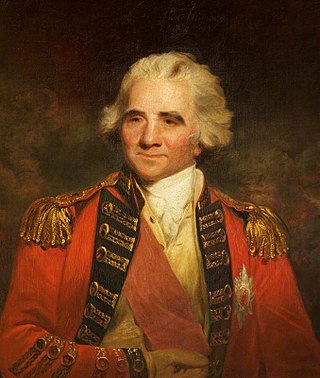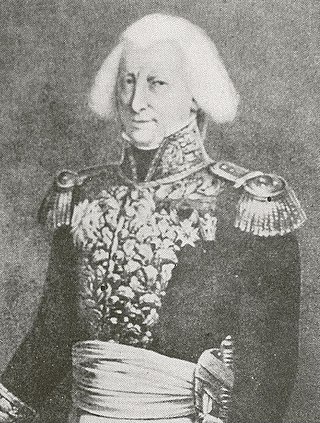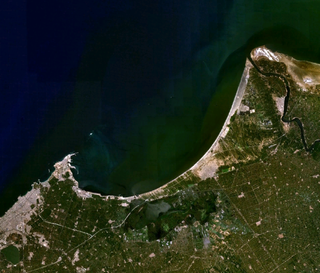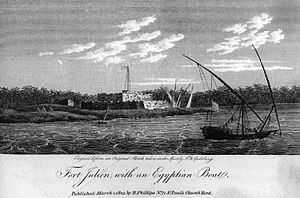
Lieutenant-General Sir Ralph Abercromby was a Scottish soldier and politician. He rose to the rank of lieutenant-general in the British Army, was appointed Governor of Trinidad, served as Commander-in-Chief, Ireland, and was noted for his services during the French Revolutionary Wars, ultimately in the Egyptian campaign. His strategies are ranked amongst the most daring and brilliant exploits of the British army.

Abu Qir, formerly also spelled Abukir or Aboukir, is a town on the Mediterranean coast of Egypt, near the ruins of ancient Canopus and 23 kilometers (14 mi) northeast of Alexandria by rail. It is located on Abu Qir Peninsula, with Abu Qir Bay to the east.

The Battle of Alexandria, or Battle of Canope, was fought on 21 March 1801 between the army of Napoleon's French First Republic under General Jacques-François Menou and the British expeditionary corps under Sir Ralph Abercromby. The battle took place near the ruins of Nicopolis, on the narrow spit of land between the sea and Lake Abukir, along which the British troops had advanced towards Alexandria after the actions of Abukir on 8 March and Mandora on 13 March. The fighting was part of the French campaign in Egypt and Syria against the Ottoman Empire, which began in 1798.

The War of the Second Coalition was the second war targeting revolutionary France by many European monarchies, led by Britain, Austria, and Russia and including the Ottoman Empire, Portugal, Naples and various German monarchies. Prussia did not join the coalition, while Spain supported France.

The siege of Acre of 1799 was an unsuccessful French siege of the Ottoman city of Acre and was the turning point of Napoleon's invasion of Egypt and Syria, along with the Battle of the Nile. It was Napoleon's third tactical defeat in his career, after three years previously being defeated at the Second Battle of Bassano and the Battle of Caldiero during the Italy campaign, and his first major strategic defeat, along with the last time he was defeated in battle for 10 years. As a result of the failed siege, Napoleon Bonaparte retreated two months later and withdrew to Egypt.

Claude-Henri Belgrand de Vaubois was a French general during the French Revolutionary Wars and the Napoleonic Wars. He is best known for the surrender of Malta to the British in 1800. On 20 August 1808 he was created Comte de Belgrand de Vaubois. Later, his name was inscribed on the Arc de Triomphe in Paris.

Admiral Sir William Sidney Smith was a British naval and intelligence officer. Serving in the American and French revolutionary wars and Napoleonic Wars, he rose to the rank of Admiral.

In the Battle of Abukir Napoleon Bonaparte defeated Seid Mustafa Pasha's Ottoman army on 25 July 1799, during the French campaign in Egypt. It is considered the first pitched battle with this name, as there already had been a naval battle on 1 August 1798, the Battle of the Nile. No sooner had the French forces returned from a campaign to Syria, than the Ottoman forces were transported to Egypt by Sidney Smith's British fleet to put an end to French rule in Egypt.

The Abū Qīr Bay is a spacious bay on the Mediterranean Sea near Alexandria in Egypt, lying between the Rosetta mouth of the Nile and the town of Abu Qir. The ancient cities of Canopus, Heracleion and Menouthis lie submerged beneath the waters of the bay. In 1798 it was the site of the Battle of the Nile, a naval battle fought between the British Royal Navy and the navy of the French First Republic. The bay contains a natural gas field, discovered in the 1970s.

The Alexandria expedition of 1807, also known as the Fraser expedition,, was an unsuccessful attempt by the British to capture the Egyptian city of Alexandria during the Anglo-Turkish War. The aim was to secure a base of operations against the Ottoman Empire and the French Empire in the Mediterranean Sea. It was part of a larger strategy against the Ottoman-French alliance of the Ottoman Sultan Selim III.

The French campaign in Egypt and Syria (1798–1801) was a Napoleonic campaign in the Ottoman territories of Egypt and Syria, executed by Napoleon Bonaparte. Napoleon proclaimed to "defend French trade interests" and to establish "scientific enterprise" in the region. It was the primary purpose of the Mediterranean campaign of 1798, which was a series of naval engagements that included the capture of Malta and the Greek island Crete, later arriving in the Port of Alexandria. The campaign ended in defeat for Napoleon after abandoning his troops to head back to France for the looming risk of a Second Coalition. This led to the death and withdrawal of French troops in the region.

The siege of Alexandria was fought during the French Revolutionary Wars between French and British forces. It was the last action of the French campaign in Egypt and Syria (1798–1801). The French had occupied Alexandria, a major fortified harbour city on the Nile Delta in northern Egypt, since 2 July 1798, and the garrison there surrendered on 2 September 1801.

The Battle of Abukir of 8 March 1801 was the second pitched battle of the French campaign in Egypt and Syria to be fought at Abu Qir on the Mediterranean coast, near the Nile Delta.

Count Honoré Joseph Antoine Ganteaume was a French Navy officer and Vice-admiral.

The siege of Cádiz was a siege of the large Spanish naval base of Cádiz by a French army from 5 February 1810 to 24 August 1812 during the Peninsular War. Following the occupation of Seville, Cádiz became the Spanish seat of power, and was targeted by 70,000 French troops under the command of the Marshals Claude Victor and Nicolas Jean-de-Dieu Soult for one of the most important sieges of the war. Defending the city were 2,000 Spanish troops who, as the siege progressed, received aid from 10,000 Spanish reinforcements as well as British and Portuguese troops.

The Capitulation of Alexandria in August 1801 brought to an end the French expedition to Egypt.

Fort Julien is a fort located on the left or west bank of the Nile about 5 kilometres (3.1 mi) north-west of Rashid (Rosetta) on the north coast of Egypt. It was originally built by the Ottoman Empire and occupied by the French during Napoleon Bonaparte's campaign in Egypt and Syria between 1798 and 1801. The fort became famous as the place where the Rosetta Stone was found in 1799.

The Battle of Mandora was a minor battle fought on 13 March 1801 between French forces under François Lanusse and the British expeditionary corps under Ralph Abercromby, during the French campaign in Egypt and Syria.
HMS Dangereuse was a tartane named Duguay-Trouin that the French Navy requisioned in May 1794 to serve as an aviso. The Navy renamed her Dangereuse either in May 1795 or on 2 March 1796. She was one of a flotilla of seven gun-vessels that Commodore Sir Sidney Smith in HMS Tigre took at Acre on 18 March 1799, all of which the British took into service. At capture Dangereuse carried six guns and had a crew of 23 men. Smith put her under the command of Lieutenant Robert William Tyte (acting).

The siege of Cairo, also known as the Cairo campaign, was a siege that took place during the French Revolutionary Wars, between French and British with Ottoman forces and was the penultimate action of the Egyptian Campaign. British commander John Hely-Hutchinson advanced to Cairo, where he arrived after a few skirmishes in mid June. Joined by a sizeable Ottoman force Hutchinson invested Cairo and on 27 June the surrounded 13,000-strong French garrison under General Augustin Daniel Belliard, out-manned and out-gunned then surrendered. The remaining French troops in Egypt under Jacques-François Menou disheartened by this failure, retired to Alexandria.



















